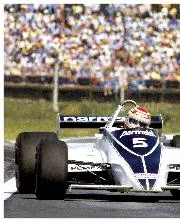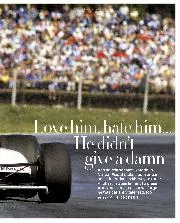He won the Brazilian Super Vee championship in ’76 and began to think about Europe. He knew it would not be easy, hadn’t even considered Formula 1, though by now Fittipaldi’s success in England was big news in Brazil. So, at the beginning of 1977, Piquet made the big decision, bought a March F3 car, signed up a couple of Brazilian mechanics and headed off for the other side of the world.
“I spoke a little bit of English but I’d forgotten most of what I learnt in America. When I arrived in Europe most people thought I was an Australian. Anyway, we did the European championship and finished third, which was not so bad,” he smiles. “Then we went to England for 1978 to do the BP and the Vandervell F3 championships.”
These early days in Europe taught Nelson a few tough lessons from which he was able to benefit when, many years later, he brought his son Nelsinho to England. Most people went out to find a sponsor and then paid a team to run them. But the Piquet way was to have his own team, his own people around him. The little band of Brazilians had proved they could take on, and beat, the best of the professional outfits.
“It helped me that I could work on the car myself,” he says. “I mean, I was a mechanic and I was always messing, fiddling with the car, making it how I wanted it. I invented tyre-warmers in Formula 3, you know that? It was a revolution,” he grins. “I made up all the bits for them and we had tyre warmers before anyone had ever thought about it. You could just fly round in the early laps, make up a lot of time. Later on, at Brabham, I told Gordon Murray about my new invention. Then they banned me from the workshop after I kept visiting every day to see what they were doing. I used to mess around with bits and pieces, do my own thing, it drove them mad. Niki Lauda got really pissed off with me being at the factory and looking at all the new bits.”

Piquet found an immediate affinity with the Brabham team
Hulton-Deutsch Collection/CORBIS/Corbis via Getty Images
Back to 1978: Nelson reckoned he needed a team manager, who spoke English and who knew where all the circuits were. “Peewee knew nothing about motor racing but he knew where everything was and he drove us everywhere. I offered him £30 a week and he told me that real team managers earned more than that. But we worked it out and he looked after us all through that year,” Nelson remembers.
And what a year it turned out to be: champion in the BP series and runner-up to Derek Warwick in the Vandervell. It was clear that the Brazilian was going to be something special. His name was already being noted, scribbled on the pads of those who constantly scouted for new talent. What caught the eye was his sheer natural speed, his lack of mistakes and some revolutionary tweaks he and his team had brought to the art of optimising the performance of Formula 3 cars.
“I had to learn how to race in the wet,” says Nelson. “We didn’t get wet races back home but again I just found it so easy, and we won a lot of races, seven in a row at one stage. Midway through the season I got a call from Mo Nunn, and by the end of July there I was, sitting on the grid at Hockenheim in an Ensign.” Just like that, the ball was coming to him, and fast.
Next it was into a McLaren M23 for Bob Sparshott at the Austrian, Dutch and Italian grands prix. He came home ninth at Monza. “I didn’t know what to do. They wanted to sign me up. I was winning in F3, working at Ralt building cars to make some money, and then Bernie Ecclestone got in touch about joining Brabham.” Nelson is talking fast, moving around a lot, as if he was back there, on the verge of his dream. “Bernie wanted me for the last race in Canada and he offered a three-year deal starting the following year in ’79.
“He said: ‘look, if you’re that good and you sign for Sparshott, you’re in the shit because you’ll be stuck there.’ That made sense, and I said OK. And, yeah, it was a cheap deal for him. I just wanted to race; it wasn’t anything to do with the money. He offered me $50,000 a season for three years but I would have driven anyway. I was going to F1.”










